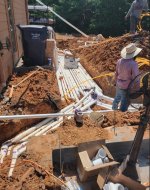- Dec 14, 2021
- 288
- Pool Size
- 24000
- Surface
- Plaster
- Chlorine
- Salt Water Generator
- SWG Type
- Pentair Intellichlor IC-60
Barring any delays, plumbing is scheduled for today and I'm reviewing the plan.
Of course there was a delay but they're onsite now and digging trenches.Unless the pump is below the water level or more than 2 feet above the water, I would not use a valve.
On the subject of check valves, the PB is advising an anti corrosive check valve is required between the heater and the salt cell. I've also been advised Jandy's largest size is 2". I'm working on getting the PN and investigating.



























